|
|
Mountain/Rock |
|---|---|
|
|
35.64248°N / 76.30541°E |
|
|
Baltistan |
|
|
Mountaineering |
|
|
Summer |
|
|
25659 ft / 7821 m |
|
|
Overview
Masherbrum is the 22nd highest mountain in the world and the 11th highest in Pakistan with a prominence of 2457m. It is located in the region of Baltistan which includes the highest peaks in the Central Karakoram. The mountain is the highest peak in the Masherbrum Mountains, which is a sub-range of the Karakoram that also includes Chogolisa (7665m) and K6 (7281m), and is located directly south of the main central crest.
Masherbrum was first reconnoitred in 1856 by Thomas Montgomerie who denoted the mountain K1 however this name is rarely used in modern day. The massif has two high points. The main (North) summit is 7821m high while the SW summit which is 7806m high. Both have been climbed although not by many. The main summit was first climbed by Americans George Bell and Willi Unsoeld in 1960 via the SW face. They were part of an American-Pakistani expedition led by Nick Clinch. The SW summit was climbed by a Polish team in 1981 although ended in disaster when two of the three summiteers died during the descent.
Masherbrum is one of the hardest mountains in climb above 7500m and has only had four successful ascents to date. Masherbrum SE has only one ascent. Many attempts have given up in response to the high risk of objective dangers. Most attempts have encountered avalanches at close quarters however, with the exception of the first ascent of the SE peak in 1981, none have ended in disaster.
Location
Masherbrum marks the high point of an east-west running ridge that includes Mandu Peak (7127m) and Yermanendu Kangri (7163m) in close proximity. Most people have seen the mountain while trekking along the Baltoro Glacier to Concordia and K2 however most climbers have attempted the mountain from the south via the village of Hushe. Both the Serac Glacier and Masherbrum Glaciers flow from the south face although all attempts have been via the former due to the latter’s objective dangers.
To the north are the Yermanendu and Mandu Glaciers. Attempts have been made beginning from both glaciers however Steve House found the latter to longer have a safe line of ascent in 2003.
What's in the Name?
The meaning of mountain’s name is unclear. Most people of Baltistan believe the name comes from the Balti words Mashadar (muzzle-loading gun) + brum (mountain) as the double summited mountain resembles an old muzzle-loader. The Raja of Khapalu has however suggested that masha means “queen” or “lady” and therefore Masherbrum means “queen of peaks”. Other less-likely possibilities are that the name comes from the Arabic word Mahsher which means doomsday. It has also been suggested that the name means “White Mountain” since burum means white in the Burushaski language of Hunza but since this language is not the local language and does not account for the meaning of masha this meaning is unlikely. (Adams Carter, 1975)Climbing History
I'm still researching the mountain's history but the bulk of it is listed below...| Year | Team | Route | Summit? | Significance | Description |
| 1938 | British team | SW Face | N | An expedition led by James Waller reached 7602m before they were avalanched. Fortunately nobody was hurt but it was decided to abort the attempt. | |
| 1955 | New Zealand team | SE Face | N | Gave up due to deep snow | |
| 1957 | British team | SE Face | N | Came within 100m of the summit | |
| 1960 | American Team | SE Face | Y | First ascent |
William Unsoeld, George Bell, Nicholas Clinch and Jawed Akhter. |
| 1976 | Japanese team | W Ridge/N Ridge | N | From a BC on the Mandu Glacier the 14 man Japanese team established camp I on the west ridge at 16000ft before the route was destroyed by an avalanche. Subsequently attempted the north ridge but only reached 18200ft before running out of time and gear. | |
| 1980 | David Belden & Christine de Colombel | SE Face | N | Reached a high point of 23625ft but descended due to bad weather and heavy snowfall after their tent had been avalanched in the night. | |
| 1981 | Polish team | SE Face | Y | First ascent of SW peak | Summited by Zygmunt Andrjej Heinrich, Marek Malatynski and Przemyslaw Nowacki formed part of a larger team. BC was established on Serac Glacier from where they climbed to the col between the two Masherbrum summits. Here they bivouacked in a snow hole before continuing to the SW summit. During another high bivouack Nowacki and Malatynski died in the night having been exposed to strong cold winds throughout as well as the preceding day. Heinrich made it back to BC but was lucky to survive a 650-1000ft fall at 24600 ft. |
| 1981 | Volker Stallbohm & Abdul Karim | SE Face | N | Reached the col between Masherbrum and Yermanendu Kangri but could not continue to the summit due to bad weather and lack of food. | |
| 1981 | American team | N Face & W Ridge | N | From a BC on the Mandu Glacier they reached a high point at 5486m where they had a close encounter with serac fall and promptly decided the route was too dangerous to continue. | |
| 1981 | British team | N | SW peak attempt | Reached 23400ft at which point bad weather broke out and they were unable to go any higher. | |
| 1983 | Japanese Team | Y | Second ascent | Masahiro Nomura and Takeyasu Minamiura summite via the same
route as the American's in 1960.
|
|
| 1985 | Japanese Team | N Ridge | Y | Third ascent, new route | Siege-style over a period of a month and a half fixing much rope. Frequent collapse of the upper glacier force them to traverse right to the NW ridge. Placed high camps at 5600m (I), 6100m (II), 6300m (III), 7200m (IV). Above camp IV the team were forced to traverse further right onto the NW Face due to rotten rock on the NW Ridge. Eventually they reached the col between the main and SW summits. All ten members reached the summit. |
| 1985 | Austrian team | NW Face | Y | Fourth ascent | A 6 man team that also sieged the mountain but fixed only 600m. Two summit attempts were made from camp III at 6300m. The first was abandoned at 7000m at which point 2 members left the expedition due to the enormous danger of falling rock and ice. On the second attempt one member gave up while the other three bivouacked at 7200m before continuing to the summit. The summiteers were Andreas Orgler, Michael Larcher and Robert Renzler. They reached the summit the day after the Japanese. |
| 1985 | British team | E Ridge from North | N | From the Yermanendu Glacier to the north they attempted the east ridge, climbing from the Masherbrum La to the summit via several subsidiary summits including Yermanandu Kangri (7821m). They was quickly thwarted due to poor snow conditions. | |
| 1996 | Russian-American team | SE Face | N | The six man expedition attempted the peak in semi-alpine style. They reached a high point of 7200m at which point they decided the avalanche risk was too great to continue. | |
| 1996 | American team | E-SE Ridge | N | Four man team led by Peter Cole reached a high point of 6050m. At camp II (5650m) they were avalanched from both sides. They were uninjured but had to wait three days for snow conditions to improve before descending to BC. | |
| 2000 | N | Details to follow | |||
| 2003 | Steve House, Marko Prezelj & Matic Jost | N ridge | N | Initially set a BC up in the Mandu Glacier however it was impossible to gain the ridge as the Austrians had done in 1985. BC was moved to the Yermanendu Glacier via a small pass. The attempt on Masherbrum was soon abandoned due to persistently poor snow conditions that lead to a number of slab avalanches. | |
| 2006 | Russian Team | NW Face | N | Objective danger of the route repeatedly increased after 4-day snowfalls meant the team went no higher than ABC (5800m) |
Getting There
All approaches are via the town of Skardu. Skardu has daily flights between Islamabad and these rarely get cancelled due to bad weather as with the Gilgit flights. The alternative is a long bus ride between Islamabad and Gilgit and a further six hours onward to Skardu. From Skardu it’s easy to hire a jeep to Askole via the Shigar Valley or Hushe via the Shyok Valley.The Southern Side
The Southern approach begins from Serac Glacier which flows into the Masherbrum Glacier. Hushe is the gateway village from where the base camp can be reached in one day. From Hushe cross the bridge to the true right (west) side of the Hushe River and follow the valley north branching left into the Masherbrum Valley.
The Northern Side
The northern base camps are approached via the Baltoro Glacier which is Pakistan’s second longest and most famous. The trek along Baltoro begins in the village of Askole to the west from where the terminal moraine of the Baltoro glacier can be reached in two days. Masherbrum is a further two days trek along the Baltoro Glacier. The glacier is fairly easy to navigate due to the large volume of trekkers breaking the route Route-finding will be required at the beginning of the season due to glacial movement through the winter.
The Eastern Side
Those ambitious enough to consider the long East Ridge from the Masherbrum La (5364m) will need to follow the true left bank of the Masherbrum River and ascend the Gondogoro Glacier in two days.
For broader information on reaching the Karakoram please refer to the Karakoram page
Red Tape
Visas
A valid visa is required. Visas are NOT issued at the airport and must be obtained prior to arrival. Some embassies such as those in Central Asia are reluctant to issue visas and advise you to obtain them from your home country. A single-entry tourist visa is valid for 3 months from the date of arrival in pakistan and for 6 months from the date of issue. Some visas are only valid for 3 months from the date of issue so check if necessary when applying. Visa prices vary. Americans pay the most for their visa whilst Japanese get theirs free! Visa extensions and reentry stamps used to almost impossible to obtain however the process has become remarkably easier in the last few years. Gilgit DC is a good place to try.
Climbing Royalties
The Ministry of Tourism has decided to maintain the 50% reduction in mountaineering royalty fees for peaks above 6500m during 2009. Royalties per expedition are based on a party of 7. Persons additional to this number will be subject to an additional royalty fee. Current royalties are listed below.
| Elevation | Normal Fee | Fee for 2009 | ||
| Expedition Royalty | Additional royalty per person | Expedition Royalty | Additional royalty per person | |
| K2 | $12000 | $2000 | $6000 | $1000 |
| All other 8000m peaks | $9000 | $1500 | $4500 | $750 |
| 7501 - 8000m | $4000 | $500 | $2000 | $250 |
| 7001 - 7500m | $2500 | $400 | $1250 | $200 |
| 6501 - 7000m | $1400 | $200 | $700 | $100 |
| Up to 6500m | $1400 | $200 | No fee | No fee |
Restricted Zone Permit
Masherbrum falls within a restricted zone when approaching from the north but not when approaching from the south. Restricted zones are areas relatively close to border areas (ie India, China and Afghanistan). In order to visit these areas a permit must be purchased from the Ministry of Tourism ($50 per person), a licensed guide hired, and a personal accident insurance policy taken out for the guide(s) and porters. The guide is required for the duration even though he will do little once at base. There are climbing guides in Pakistan however few are any good by Western standards (this is probably the wrong mountain to be climbing anyway if you require a guided ascent). One member must attend a mandatory briefing and debriefing at the Ministry of Tourism in Islamabad although many skip the debriefing. Most people use a trekking company in Pakistan who will provide a licensed guide, deal with bureaucracies and make all arrangements.
The above requirements are only for foreigners. Pakistanis who are not from the Northern Areas can easily visit these areas without a permit.
When to Climb
The mountaineering season runs from June to September with July and August being the most popular months to climb in Pakistan. No peaks of Masherbrum's size have been climbed in the Karakoram during the winter months due to the severe conditions. Masherbrum would be a very poor choice for a winter Karakoram ascent concidering the frequency of avalanches in the summer months.The Ks of the Karakoram
Masherbrum is rarely referred to as K1 in modern day. The “K” mountains refer to those that were reconnoitred by British Royal Engineers lieutenant Thomas Montgomerie.
The original “K” mountains are:
K1 - Masherbrum (7821m)
K2 - K2 (8611m)
K3 - Broad Peak (8047m)
K4 - Gasherbrum II (8035m)
K5 - Gasherbrum I (8080m)
K6 - K6 (7282m) (Baltistan Peak)
K7 - K7 (6942m)
K12 - K12 (7428m)
Other Peaks of the Masherbrum Mountains
SP Pages
[img:207769:alignright:small:North Face of Masherbrum]
Laila Peak (6200m)
Mitre Peak (6010m)
Amin Brakk (5800m)
External Links
Report on 2006 Russian attempt of NW FaceMore to follow shortly...







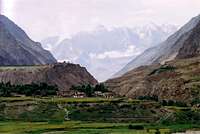

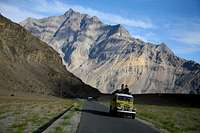
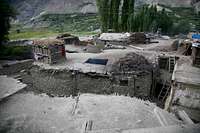




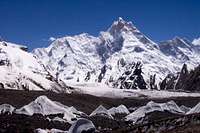

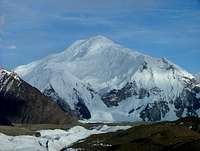

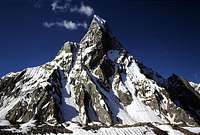



aaporik - Oct 8, 2009 12:50 am - Voted 9/10
Climbing HistoryMasherbrum 7821 SE Face Masherbrum 7821m was climbed back in 6th and 8th July 1960 by two American Bell Clinch and his friend with Akhtar a Pakistani from South East Face. Since then it took 23 years before a second ascent made by the Japanese Kakeyasu Minamura and Masuhino Nomura in August 1983. Another Japanese expedition in 1985 climbed the impressive and most beautiful North West Ridge and North Face. Masherbrum also called K1 name by British survey team in 1856 while sequencely naming the peaks in Karakoram Range local name of this beautiful peak is Masherbrum. The normal route to Masherbrum Peak 7821 meters is from Hushey Valley of Baltistan. A two days walk from Hushe will bring you the green meadow of Masherbrum Base Camp at 3500m Masherbrum standard route is from South East and has 4 high altitude camps. Take a direct line up the icefall and then climb the crest of the Dome ridge, rather than taking the skirt the icefall on the right and making a long traverse to the Dome and to its top. This way one would rid of the dangerous avalanche on the traverse. Camp 1 is at an altitude of 5,000 meters on the plateau between a rocky outcrop that guards the icefall on the left and the Dome, follow the icefall, the icefall can be seen as consisting of three giant steps. First can be climb by the middle, bearing right at its top. Second camp 2 is at 6100m on the huge plateau behind the Dome. Camp 3 is at 6600m under the summit pyramid. The last Camp 4 is at 7200m. Since then many mountaineers from all over the world tried their luck including Satoshi Kawahara and Lev Loffe Russian /American team. Lev Loffe originate from Russia now teaching in America a regular visitor to Pakistan tried this peak from Normal route in 1996 from Hushe valley and manage to reach 7200m, I was part of his 1996 expedition as a Liaison Officer. Lev Loffe again return in 1999.In the same season of 1996 a Pakistani Army expedition manage to reach the summit of Masherbrum II 7806m with the help of high altitude porters, their base camp was two hours down from our main base camp.
Shahid Hussain - Apr 20, 2019 4:14 am - Hasn't voted
updated informationThank you for the great information about Masherbrum. I have noted that this article was written in 2007. There are so many changes took place during the last 12 years period. For 2019, Royalty fee for Masherbrum is, USD $2400 for 7 members group, USD $ 300 Per additional person. Environment Fee/Waste Management Fee will be 68 US$ for each member of mountaineering expedition. Currency: Pakistani Rupee. 141.60 Rps = 1 US$ in April 2019. Flight from Islamabad To Skardu is very frequent. Pakistan International Airline is operating an Airbus PK451on daily basis. From Islamabad To Skardu is now only 20-22 Hours drive via Babusar Pass or via Karakoram Highway. It would be wise to contact a local Tour Operator to organise the trip, Documentations and get up to date information. One of the oldest and Government licence Tour Operator from Skardu is Trango Adventure. they will be happy to provide the Latest and up to date informations. info@trangoadventure.com https://www.trangoadventure.com
aaporik - Oct 26, 2021 9:52 pm - Voted 9/10
Masherbrum AreaRecently the trekking fee is increased and now one has to pay 150 dollars per person to get a trekking permit to climb below 6500 peaks. Additionally you need to pay Central Karakoram National Park fee too. For climbing above 6500 meters in any region you need to pay 200 dollars per person for Central Karakoram National Park fee. other then peak royalty fee.